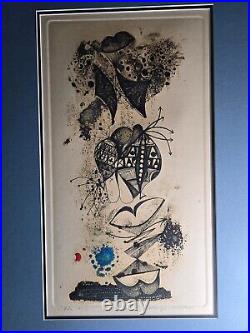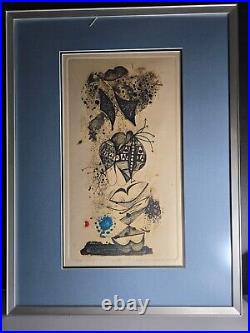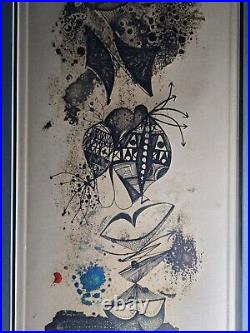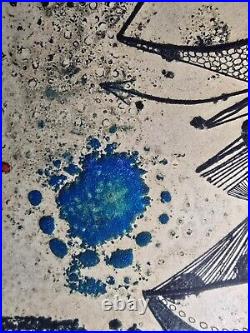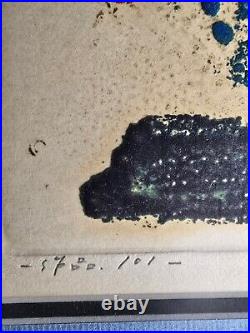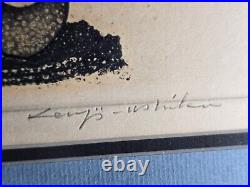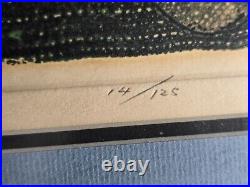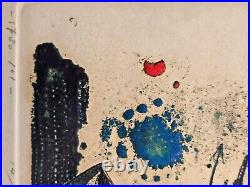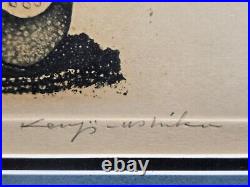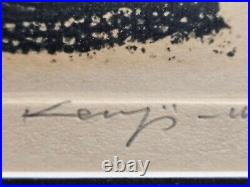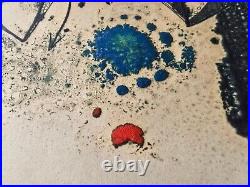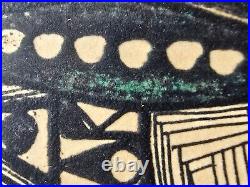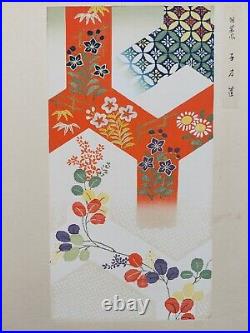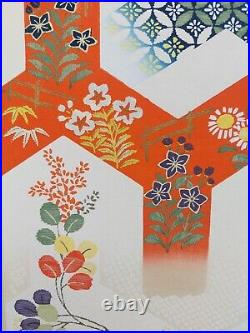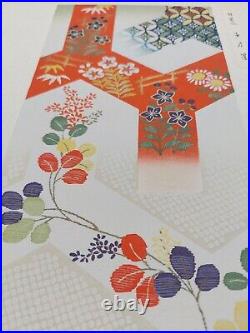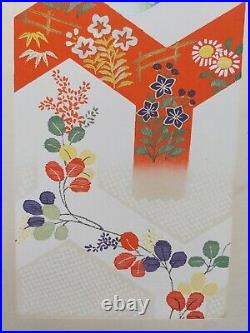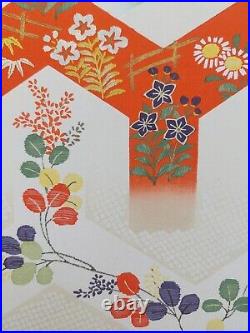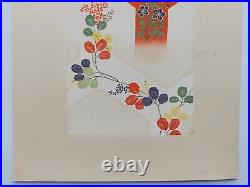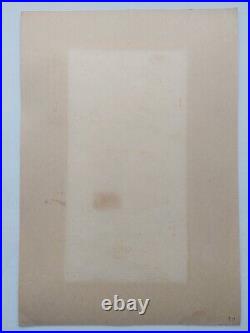YAMASHIRO Province Utagawa Hiroshige Japanese Woodblock Framed Art Print 18×15. PROVINCE DE YAMASHIRO, ARISHIYAMA, LE PONT DE TOGETSU (THE MOON CROSSING BRIDGE AT ARISHIYAMO) It is a very beautiful re-print of the original. This is one in a series of 69 prints. As of this listing, I have 35 of them, all professionally framed in a brushed silver toned frame and matted in black They all came from the same Estate in Louisville, KY. All are in excellent condition and any one or all of them would add greatly to your Asian art collection. The last 5 pictures are from one of these that had a damaged back. I deconstructed it so you could see all the layers and materials involved. It depicts the Togetsukyo Bridge in Arashiyama, Kyoto, a well-known scenic spot. The bridge, meaning “moon crossing bridge, ” got its name from Emperor Kameyama, who thought the moon looked like it was crossing the bridge during a boat party. The print showcases the bridge with cherry trees in bloom, a popular seasonal attraction. While the bridge appears wooden, its structure is reinforced concrete, with only the parapets made of cypress wood. The artwork is a vertical oban print, a format that allowed Hiroshige to experiment with perspective and create a sense of depth. The print is a later variant, recognizable by the darker sky and different coloring of the clouds and cartouche compared to earlier versions. The bridge has a long history, with the first version built in 836, though the current structure dates to 1934. Born in Edo as Tokutaro Ando, Hiroshige Utagawa grew up in a minor samurai family. His father belonged to the firefighting force assigned to Edo Castle. It is here that Hiroshige was given his first exposure to art: legend has it that a fellow fireman tutored him in the Kano school of painting, though Hiroshige’s first official teacher was Rinsai. Though Hiroshige tried to join Toyokuni Utagawa’s studio, he was turned away. In 1811, young Hiroshige entered an apprenticeship with the celebrated Toyohiro Utagawa. After only a year, he was bestowed with the artist name Hiroshige. He soon gave up his role in the fire department to focus entirely on painting and print design. During this time he studied painting, intrigued by the Shijo school. Hiroshige’s artistic genius went largely unnoticed until 1832. With the Tokugawa Shogunate relaxing centuries of age-old restrictions on travel, urban populations embraced travel art and Hiroshige Utagawa became one of the most prominent and successful ukiyo-e artists. He also produced kacho-e (bird-and-flower pictures) to enormous success. In 1858, at the age of 61, he passed away as a result of the Edo cholera epidemic. Hiroshige Utagawa’s woodblock prints continue to convey the beauty of Japan and provide insight into the everyday life of its citizens during the Edo period. The appeal of his tender, lyrical landscapes was not restricted to the Japanese audience. Hiroshige’s work had a profound influence on the Impressionists and Post-Impressionists of Europe: Toulouse-Lautrec was fascinated with Hiroshige’s daring diagonal compositions and inventive use of perspective, while Van Gogh literally copied two of Hiroshige’s prints from the famous series, 100 Famous Views of Edo in oil paint. Hiroshige (1797 – 1858). Mimasaka Province, Yamabushi Valley. Series: Famous Places in the 60-odd Provinces. Size (H x W): 14.5 x 10.75 (inches). Publisher: Koshimuraya Heisuke (Koshihei). Seals: Date and Aratame. Condition: Very good color and impression, light soiling and wear, embellished with mica.
Archive for March 15th, 2025
YAMASHIRO Province Utagawa Hiroshige Japanese Woodblock Framed Art Print 18×15
Author: adminMar 15
Kenji Yoshida. Beautiful Vintage Artwork Woodblock Print
Author: adminMar 15
Discover the intricate artistry of Kenji Yoshida with this exquisite vintage woodblock print. The piece showcases a vivid multi-color palette, expertly captured on high-quality paper, reflecting the rich cultural heritage of Japan. It is a genuine vintage original, promising to add a touch of timeless elegance and historical value to any collection. Though the exact age of the print is not known, it bears the distinctive mark of Yoshida’s craft, revered for its detail and craftsmanship. This artwork is not just a visual delight but also a testament to the enduring legacy of Japanese art and printmaking traditions.
JAPANESE WOODBLOCK PRINT SHIN HANGA ORIGINAL ANTIQUE Japanese Design 1920s
Author: adminMar 15
ARTIST: Yamamoto Sekkei (SEKKA YAMAMOTO). AGE: APPROX 100 years old. MEDIUM: WOODBLOCK PRINT (INK ON PAPER) NISHIKI-E. SIZE: 16 inches by 10.5 inches (41 cm X 27 cm). GENRE: JAPANESE PATTERN DESIGNS. CONDITION: (see detailed pictures) Some have stains, foxing. DESCRIPTION: deluxe printing techniques, metallic pigments, splashed gofun, etc. Were used in the making of many of the prints in this series. COMMENTS: BEAUTIFUL COLORS, GREAT IMPRESSION.















